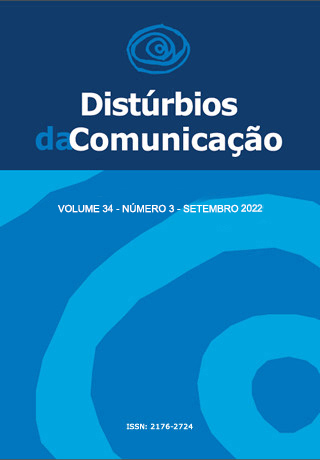Características de deglutição e ingestão oral pré e pós acompanhamento fonoaudiológico de pacientes traqueostomizados internados em um hospital universitário
DOI:
https://doi.org/10.23925/2176-2724.2022v34i3e52646Palavras-chave:
Fonoaudiologia, Traqueostomia, Transtornos de deglutiçãoResumo
Introdução: A traqueostomia pode impactar na deglutição e gerar alterações neurofisiológicas e mecânicas. Objetivo: Analisar a funcionalidade da deglutição em pacientes traqueostomizados internados em um hospital universitário, pré e pós intervenção fonoaudiológica por meio da análise de protocolos do serviço – Protocolo Adaptado (base na escala FOIS e Protocolo de Avaliação do Risco para Disfagia – PARD). Método: Estudo transversal, retrospectivo, analítico observacional, de abordagem quantitativa. Analisados 114 protocolos de avaliação da deglutição, verificou-se o grau de disfagia conforme a classificação de O’Neil e escala FOIS em um período de quatro anos. Pesquisa aprovada pelo Comitê de Ética em Pesquisa da Instituição (29894920.5.0000.5349). Resultados: Após analisados os protocolos constataram-se que a maioria era do sexo masculino com média de idade de 54,55 anos. Observou-se a predominância das seguintes comorbidades prévias de saúde: pneumonia, hipertensão arterial sistêmica e acidente vascular encefálico isquêmico. Após o acompanhamento fonoaudiológico houve melhora da biomecânica da deglutição com mais pacientes apresentando deglutição funcional – um (0,9%) para 12 (10,5%), redução do número de sujeitos com disfagia grave – 32 (28,1%) para 17 (14,9%) e maior ingestão por via oral – 79 (69,3%) dos pacientes aumentaram o nível de ingestão oral conforme a escala FOIS. A maior parte da amostra apresentou boa tolerância à oclusão de traqueostomia e 60 (52,6%) progrediram para decanulação. Conclusão: A presença da traqueostomia impactou sobre a funcionalidade da deglutição, pois a maioria dos pacientes possuía algum grau de disfagia. Ressalta-se a importância da atuação fonoaudiológica no processo de reabilitação da deglutição, auxiliando no processo de decanulação.
Downloads
Referências
Silva CR, Cunha HPS. Ocorrência de broncoaspiração de saliva em pacientes traqueostomizados [trabalho de conclusão de curso]. Porto Velho (Rondônia): Centro Universitário São Lucas de Porto Velho; 2016.
Côrte MMD, Vicente LCC, Friche AAL. Decanulação: indicadores sociodemográficos, clínicos e fonoaudiológicos preditivos de sucesso. Audiol. Commun. Res. 2019; 24(e): 1-9. doi: 10.1590/2317-6431-2018-2103.
Medeiros GC, Sassi FC, Lirani-Silva C, Andrade CRF. Critérios para decanulação da traqueostomia: revisão de literatura. CoDAS. 2019; 31(6): 44-50. doi: .1590/2317-1782/20192018228.
Dedivitis RA, Santoro PP, Sugueno LA. Manual prático de disfagia: diagnóstico e tratamento. 1th. ed. Rio de Janeiro: Revinter; 2017.
Crary MA, Mann GD, Groher ME. Initial psychometric assessment of a functional oral intake scale for dysphagia in stroke patients. Arch Phys Med Rehab. 2005; 86(8):1516-20. doi: 10.1016/j.apmr.2004.11.049.
Padovani AR, Moraes DP, Mangili LD, Andrade CRF. Protocolo fonoaudiológico de avaliação do risco para disfagia (PARD). Rev. soc. bras. fonoaudiol. 2007; 12(3): 199-205.
Thompson-Henry, S., Braddock, B. The modified Evan’s blue dye procedure fails to detect aspiration in the tracheostomized patient: Five case reports. Dysphagia. 1995; 10(3): 172-4.Doi: 10.1007/BF00260973
O’Neil KH, Purdy M, Falk J, Gallo L. The dysphagia outcome and severity scale. Dysphagia. 1999; 14(3): 139-45. doi: 10.1007 / PL00009595.
Abe T, Madotto F, Pham T, Nagata I, Uchida M, Tamiya N et al. Epidemiology and patterns of tracheostomy practice in patients with acute respiratory distress syndrome in ICUs across 50 countries. Critical Care. 2018; 22(195): 1-16. doi: 10.1186/s13054-018-2126-6.
Favero SR, Scheeren B, Barbosa L, Hoher JA, Cardoso MCAF. Complicações clínicas da disfagia em pacientes internados em uma UTI. Distúrb Comun. 2017; 29(4); 654-62. doi: 0.23925/2176-2724.2017v29i4p654-662.
Lopes AVR. Perfil epidemiológico e o sucesso/insucesso da ventilação mecânica. Rev. Cient. X SIMPAC; 6 Jun 2018; Viçosa, MG. ANAIS SIMPAC; 10(1): 74-9; 2018.
Rodrigues KA, Machado FR, Chiari BM, Rosseti HB, Lorenzon P, Gonçalves MI. Reabilitação da deglutição em pacientes traqueostomizados disfágicos sob ventilação mecânica em unidades de terapia intensiva: um estudo de factibilidade. Rev. Bras. Ter. Intensiva. 2015; 27(1): 64-71. doi: 10.5935/0103-507X.20150011.
Junior JGS, Silveira JM. Influência da traqueostomia no tempo de ventilação mecânica. Ver. Amazônia Science & Health. 2017; 5(1): 35-9. doi: 10.18606/2318-1419.
Zanini, Martini TF, Santos FS, Rovedder PE, Stein R. Associação da função pulmonar e capacidade funcional com o tempo de ventilação mecânica invasiva após cirurgia de revascularização do miocárdio. Arq. Ciênc. Saúde. 2018; 25(2): 42-6. doi: 10.17696/2318-3691.25.2.2018.896.
Mateus AP, Ruivo EAB, Troncoso EAM, Kubayashi V, Ferreira LL, Werneck AL. Desmame de traqueostomia em pacientes neurológicos responsivos e arresponsivos [periódico na internet]. Arq. Ciênc. Saúde. 2017 [acesso em 29 Jun 2020]; 24(2): [6p.]. Disponível em: https://www.cienciasdasaude.famerp.br/index.php/racs/article/view/613/689 .
Jesus SC. Silva BCA, Queiroz CA. Desfecho clínico de pacientes submetidos à traqueostomia precoce e tardia. 17º Congr. Inic. Cient. FASB. Mai 10; Barreiras, Ba; 2019.
Freeman BD. Tracheostomy update. Crit. Clin. Care. 2016; 33(2): 311-22.
Mah JW, Staff II, Fisher SR, Butler KL. Improving decannulation and swallowing function: A comprehensive, multidisciplinary approach to post-tracheostomy care. Resp. Care. 2017; 62(2): 137-43. doi: 10.4187/respcare.04878.
Oliveira EL, Rocha CR, Vanvos-sem MR. Critérios para decanulação eficaz: uma revisão de literatura. Rev. Insp. 2017; 14(4): 43-7. ISSN: 2175-537X.
Mallmann LP. Manejo do paciente traqueostomizado e decanulação – o papel do intensivista além da UTI. REINPEC. 2019; 5(2): 112-34. doi: 10.20951/2446-6778/v5n2a9.
Medved DMS, Marques AHB. Eficácia da remoção da cânula de traqueostomia por equipe interdisciplinar: série de casos. Ceafi. No prelo 2019; 1-9.
Belafsky PC, Blumenfeld L, Lepage A, Nahrstedt K. The accuracy of the modified Evan’s blue dye test in predicting aspiration. Laryngoscope. 2003;113(11):1969-72. doi: 10.1097/00005537-200311000-00021.
Billington J, Luckett A. Care of the critically ill patient with a tracheostomy. Cardiorespiratory. 2019; 34(2): 59-65. doi: 10.7748/ns.2019.e11297.
Downloads
Publicado
Edição
Seção
Licença
Copyright (c) 2022 Jainara Medina Teixeira, Karen de Oliveira dos Passos, Sheila Petry Rockenbach

Este trabalho está licenciado sob uma licença Creative Commons Attribution 4.0 International License.









